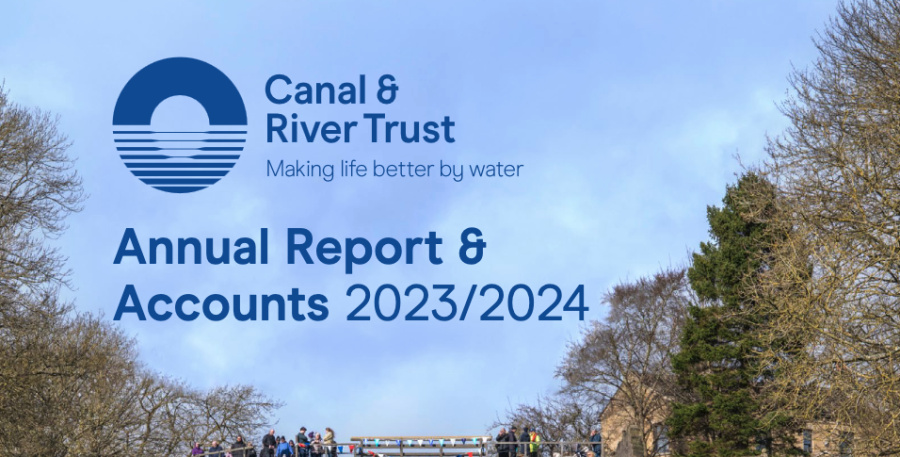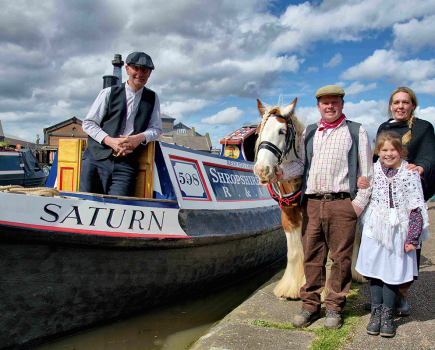The Canal & River Trust has published its Annual Report & Accounts for the year 2023/24.
It was a year of record spend on charitable activity, but one that saw the continued effect of climate change taking its toll on the Trust’s ageing canal infrastructure. The waterways movement came together to raise the profile of the considerable benefits to society delivered by the Trust and its historic canal network following an announcement about future funding cuts by government.
Work to repair and strengthen the resilience of the canal network during the year included almost 450 planned engineering projects, at a cost of around £70 million. Delivering statutory safety measures at the charity’s large reservoirs, critical for navigation and in protecting the communities around them, continued to dominate expenditure, with over £27 million spent on resilience works at 19 of the Trust’s 71 large reservoirs.
Reflecting the continued impact of climate change on the ageing canal network, the Report details how, following prolonged hot dry weather the summer before, a succession of winter storms caused significant damage, with an aggregated impact of £9 million in emergency works.
The rising cost of looking after the Trust’s 2,000-mile canal network is reported, with two years of high inflation significantly pushing up many of the Trust’s maintenance costs. This underscores the challenge presented by the Government grant settlement, announced in July 2023, with steep funding cuts to be applied from 2027. Coming after a six-year period when the grant has been frozen (and hence its value has already fallen by over 30% in real terms), the Trust reports that this presents a very challenging prospect, putting the future of the canal network in jeopardy.
David Orr, chair of the Canal & River Trust, comments: “Our canal network is a national treasure – unique living heritage dating back 250 years that connects our past to the present – and is able to play a vital role in our future prosperity.
“Navigable canals and their free access to towpaths provide green-blue spaces on the doorstep for millions of people. They offer places to exercise and connect with nature and are traffic-free green corridors for active travel and nature recovery. Supporting jobs and the economy, today’s canals play an important role in the nation’s water and utilities infrastructure, and even delivering new sources of renewable energy.
“In key policy areas for government, a thriving and navigable canal system delivers a magnitude more benefit than the investment that keeps it safe and cared for. Whilst we are continuing to grow commercial and charitable funding, there is still a requirement for government to work in partnership with our charity to ensure an adequate contribution is made that is vital to help safeguard this amazing industrial heritage network for future generations.”
Alongside the Trust’s #KeepCanalsAlive campaign launched in the year, over 100 organisations played a role in raising the profile of waterways funding via the Fund Britain’s Waterways coalition, including via a series of rallies and events.
In March 2024, the Trust published its first Impact Report (Transforming Places and Enriching Lives), which brings together numerous examples of the effect of the charity’s work, as well as independent assessment of the network’s aggregate value – delivering £4.6 billion in annual social benefits and £1.5 billion in economic benefits. A second Impact Report will be published later this year.
The Trust continued to track the changing trends in boating. Across the network, the total number of boats with a home mooring decreased by 3.7%, while the total number of continuously cruising boats increased by 4.9%, with overall boat numbers dipping by 1.4% to 32,602 in its annual National Boat Count. The first-ever Boater Census was published, highlighting the differing needs of those who live aboard or boat for leisure. The Trust is committed to listening to the concerns of boaters and to addressing them, including a focus on getting the basics right on canal maintenance and improving communication.
Richard Parry, chief executive of the Canal & River Trust, comments: “A key part of the Canal & River Trust’s long-term plan is to continue to reduce dependency on government funding by further developing and growing alternative sources of income. During the year ended 31 March 2024, our commercial income was £97.1m, 12.2% higher than in the prior year. It now represents 41.0% of our total income (2022/23: 38.1%).
“Our charitable income has started to rise as our fundraising team is developing its plans to deliver significant growth in the years ahead. It’s also essential that we control our costs as far as possible, and we’re adopting new and innovative ways of doing things where practicable.
“Key to our future is the growing role of our volunteers and, as we make volunteering integral to everything we do, this year we’ve achieved record numbers of volunteers and hours given.
“Our charity is committed to maintaining the network in good working condition for the benefit of our boating customers, the millions of regular towpath users, and the tourists who flock from around the country and the globe to experience it, and to protecting neighbouring homes and businesses from the threat that our ageing infrastructure could pose if not well-managed and cared for.”
The Trust’s Annual Report & Accounts is available online at: https://canalrivertrust.org.uk/about-us/annual-report-and-accounts. Its Annual Public Meeting will be held online at 1pm on 6 November.








